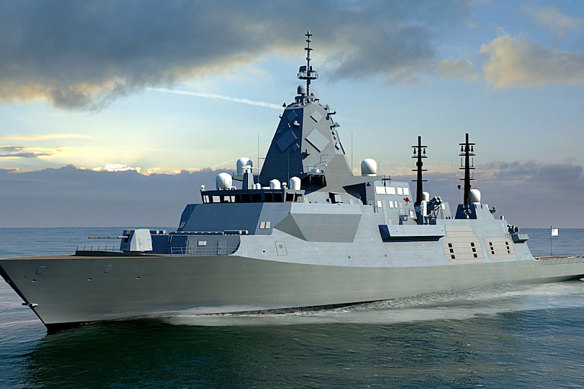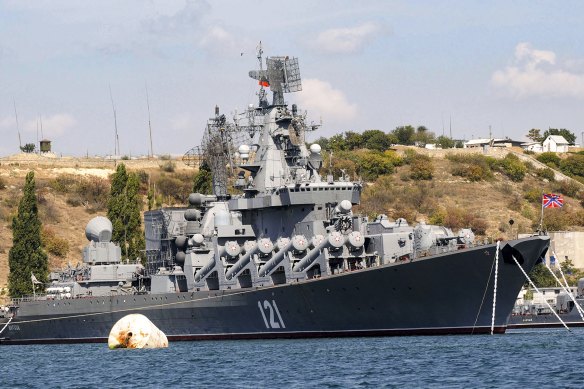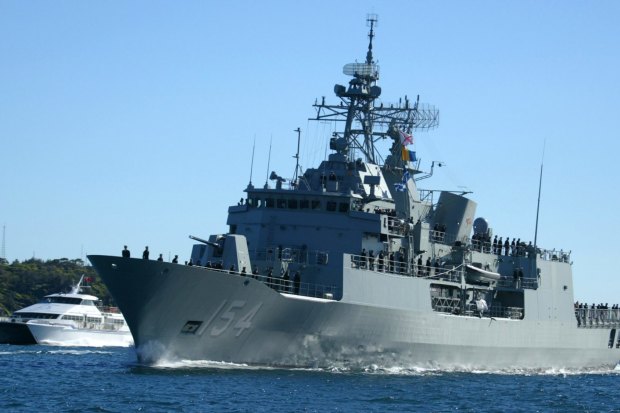This was published 1 year ago
Floating ‘turkeys’: Is Australia spending $50bn on dud ships?
Flanked by senior cabinet ministers, South Australia’s premier and the country’s top military leaders, Malcolm Turnbull looked ebullient as he proclaimed June 29, 2018, a “great day for Australia’s security”.
The then prime minister was at the Osborne naval shipyard to announce British defence firm BAE Systems the winner of a $35 billion contract to build a fleet of nine frigates for the Royal Australian Navy. It turned out to be one of Turnbull’s last big announcements before being ejected from the Lodge.
In an era of rising geostrategic tensions, Turnbull enthused that Australia was acquiring the “most advanced anti-submarine warships in the world”. And not only that. The decades-long project would lay the foundation for a “truly sovereign national Australian shipbuilding industry”, creating 4000 direct jobs in Adelaide (the home town, it just so happened, of then defence industry minister Christopher Pyne).
Across the other side of the world, Theresa May was delighted that BAE Systems had fended off bids by rival Spanish and Italian firms to build what would be known as the Hunter-class frigate. The then British prime minister hailed the contract as a sign the United Kingdom could prosper in a post-Brexit world by partnering with nations like Australia.

Defence Minister Richard Marles will consider how many Hunter-class frigates to build when a major naval review is finished.
Known as the Type 26, the 150-metre frigate would be fitted with an Australian radar and a state-of–the-art American combat system. Digital illustrations of the gleaming, ultra-modern leviathan certainly looked impressive.
However, from the very beginning, there were questions about the high level of risk involved. The British Navy was years away from completing construction on its first Type 26 frigate; adding Australian and US parts to the design would only add to the complexity.
Two years after the announcement, the cost of the program was revised up by $10 billion to $45 billion. Soon after, Defence acknowledged that the project was running 18 months to two years behind schedule, with the first ship expected to enter service in the early 2030s rather than the late 2020s. Design changes saw the weight of the ship blow out from 8800 tonnes to about 10,000 tonnes.
“If you try to Australianise an already immature design, you’re setting yourself up for serious problems and that’s exactly what happened,” says Richard Dunley, a naval historian at UNSW.
‘I don’t know anyone who thinks the Type 26 is the right ship for us to be buying.’
Hugh White, former deputy secretary of the Department of Defence
Beyond the navy’s leadership and BAE’s representatives, it is now hard to find fans of the Hunter-class frigate.
“I don’t know anyone who thinks the Type 26 is the right ship for us to be buying,” says Hugh White, a former deputy secretary of the Department of Defence.
Another prominent defence analyst, speaking on condition of anonymity because of work they do for the federal government, lambasts the ships as floating “turkeys”.
“This is heading down the pathway to be the worst shipbuilding project in the RAN’s history,” the analyst says.
David Shackleton, who served as the chief of navy from 1999 to 2002, said in a major report for the Australian Strategic Policy Institute last year that the Hunter-class program was so fundamentally flawed that it should be scrapped.
A scathing audit office report released in May found the final cost was likely to be “significantly higher” than $45 billion. It also revealed that the Defence Department initially concluded that the Italian and Spanish designs were better options for Australia than BAE’s Type 26 ship.
The future of the program was expected to be resolved by the Albanese government’s Defence Strategic Review, released in April. Instead, it recommended the government conduct a separate, short-and-sharp review into the nation’s surface fleet.
Defence Minister Richard Marles received the top-secret review, led by former United States Navy admiral William Hilarides, last week and says he is carefully considering its recommendations. The stakes are high: alongside the AUKUS nuclear-powered submarines, the surface ships Australia decides on will be the navy’s primary combat power for the next 50 years. International companies, smelling money in the water, are circling with offers off cheaper, smaller ships.
Among those highly critical of the Hunter-class frigates is Peter Dean, who served as a senior adviser to the Defence Strategic Review and its principal author.
“What we have here is an over-engineered, over-specialised, anti-submarine warfare frigate that is no longer meeting the needs of the strategic environment,” says Dean, foreign policy and defence director at the United States Studies Centre.
“The question now has to be: are we not better off walking away and looking at other options that we can explore?”
Around the world, even more profound questions are being asked about the viability of large surface ships in an era of precision missiles, drones and sophisticated surveillance systems.
‘The question now has to be: are we not better off walking away and looking at other options that we can explore?’
Peter Dean, foreign policy and defence director at the United States Studies Centre
Named after the Russian capital, the Moskva was the pride of President Vladimir Putin’s Black Sea Fleet. The 9000-tonne, 186-metre cruiser was seen as so significant, so formidable, that the Russian Orthodox Church handed over a Christian relic, believed to be a piece of the True Cross on which Jesus Christ was crucified, to grace the ship’s chapel. The Moskva played an important role in Putin’s invasion of Georgia in 2008 and Crimea in 2014, and was expected to do so again in the war in Ukraine.
Yet, last April Ukraine spectacularly shot down the Moskva using cheap, locally made Neptune cruise missiles launched from land near the port city of Odessa. It was the biggest ship to be sunk in combat since 1982 when the British navy famously downed the General Belgrano during the Falklands War.

Moskva, Russia’s Black Sea flagship, was sunk by Ukraine last April in a major blow to national pride.Credit: AP
Retired US Navy admiral James Stavridis applauded the sinking as “gut punch to the Russian military and the Kremlin”, but added that it offers “a stark reminder of the vulnerability of surface ships — including aircraft carriers, the heart of the US Navy — to relatively low-cost, numerous and technologically advanced cruise missiles”.
Stavridis said that, in the two decades since September 11, 2001 attacks, Western navies had “operated with impunity, projecting power ashore at will because Afghans, Iraqis and Syrians did not have Neptune-style cruise missiles”.
“That won’t be the case in great-power conflict,” he wrote in Bloomberg Opinion, alluding to a possible battle between the US and China, most likely in the Taiwan Strait.
Andrew Davies, a senior Australian Strategic Policy Institute analyst and former Defence official, says surface ships have always had major vulnerabilities. They are large and slow, their defensive systems can’t be reloaded at sea and can only manoeuvre in two dimensions. Recent technological developments, he argues, have tipped the balance to render them virtually useless in war-fighting scenarios.
Firstly, there are the rapid advances in radar and sonar technology — including from space satellites — that make ships far easier to detect. “Once a ship sailed over the horizon, it used to be invisible,” he says. “Now they can be easily detected at long ranges.” At the same time, advances in precision-guided missiles are making them easier to sink. Adding to the threat matrix are attacks from drones and explosive uncrewed underwater vessels.
“My argument has been for a very long time that surface ships have no serious place in Australian military strategy in any conflict with a capable maritime power,” says White, the former Defence official.
“They’re so vulnerable, and there are so many other ways of doing everything that surface ships can do for you.”
Dean says: “There is a fundamental question about the long-term utility of very large surface vessels. It doesn’t mean that their time has necessarily come and gone, but the mass proliferation of cheap and ubiquitous cruise missiles make them much more vulnerable.”
However, even the biggest sceptics accept that a vast island nation like Australia must have surface ships of some kind. As well as war-fighting, such vessels serve an important role in providing humanitarian assistance and disaster relief to the wider region, as well as counter-piracy operations. The live question is, at cost of $5 billion each, whether the Hunter-class is the correct ship for Australia and whether nine are really necessary.
++
Ben Hudson, the chief executive of BAE Systems Australia, accepted that the Hunter-class project had hit choppy waters while appearing before a Senate committee in September.
“However, as one of the most complex and technologically demanding projects undertaken in Australia, challenges are to be expected,” he said, pointing to delays caused by the COVID-19 pandemic and inflationary pressures.
Stressing that the ship’s primary role was anti-submarine warfare, Hudson said his company was committed to providing Australia with a “formidable” frigate whose capabilities are “currently without peer”.
From the beginning, the biggest selling point of the Type 26 was its ability to hunt down and shoot enemy submarines.
Rather than an advantage, White says this is the hole in the heart of the program.
“As a wit once said, searching for a submarine with a surface ship is a bit like searching for a gas leak with a match,” he quips. “You’ll find the submarine, but only when the torpedo is in the water and heading towards you.”
You’re far better off searching for submarines with aircraft or other submarines, he says.
Michael Shoebridge, a former senior Defence Department official, says Australia’s plan to acquire nuclear-powered submarines under the AUKUS pact has undermined the rationale for the Hunter-class program.
“The primary purpose of a Virginia-class attack submarine is to kill other submarines,” says Shoebridge. “That should free up the frigates to not be so focused on anti-submarine warfare.”

The Hunter-class frigates will weigh three times as much as the current ANZAC-class frigates.Credit: Reuters
White also criticises the ships’ colossal heft, noting they will weigh three times as much as the current ANZAC-class frigates.
“What’s the strategic rationale for this very significant step change?” he asks. “The answer is: there is none.”
The most common complaint is that, despite their size, the frigates are not equipped to carry enough ammunition — a glaring flaw given Marles has made boosting the defence force’s long-range strike capability his central goal as defence minister.
“While other navies around the region are growing the number of missile cells they can put on surface combatants, we’re going backwards,” Dean says.
In his Australian Strategic Policy Institute report, Shackleton argued: “Having only 32 missile cells, the Hunter frigate is fundamentally under-armed for almost any operation in which hostilities are to be expected ... If the evolution of the Hunter design won’t allow it to embark at least 96 cells, then its viability must be questioned.”
This problem of being under-gunned is not limited to frigates. The government is also building 12 offshore patrol vessels, known as the Arafura class, in Adelaide at a cost of $3.6 billion. The vessels have only meagre weaponary, limiting their ability to contribute to any high-end military scenarios.
“I think historians will judge that the rush to massive investments in major surface ships that took place under the Turnbull government, and which has been sustained by subsequent governments, was really all about building up jobs in South Australia,” White says.
++
So what answers could the surface fleet review come up with? All experts acknowledge the government faces a fiendishly difficult problem with no easy solutions. “This is a very serious game of Tetris,” Dean says.
Marles has said the government would not respond to the review until next year, suggesting its recommendations are substantial, complicated or expensive (possibly a combination of all three).

Defence Minister Richard Marles says the government will not respond to the review until next year.Credit: Alex Ellinghausen
“We will take the necessary time to consider this analysis to ensure we have an appropriately balanced surface fleet that contributes to a fully integrated and more capable Defence Force,” he said after receiving the report last week.
In the lead-up to the defence strategic review, there was a widespread expectation that the government would slash the order of Hunter-class frigates from nine to six to free up more money. That speculation continues, with naval historian Richard Dunley thinking it remains the most likely outcome.
As flawed as the program is, Dunley says: “The fastest way to get capability is probably to stick with Hunter-class, which is why I suspect any cuts will come to the last three hulls.”
Michael Shoebridge thinks the government should be bolder and slash the number of frigates to three.
Dean is no fan of either option because they would not release any money in the near term. “If you go from nine frigates to six — or even from nine down to three — the government won’t get a single dollar back over the next 10 years,” he says.
Dean says the government has two feasible options. It could double-down on the Hunter-class program and seek money elsewhere in the budget to beef up the navy’s firepower. Otherwise, it should abandon the program entirely, freeing up billions of dollars to spend on a mix of large and smaller ships. Among these could be a fleet of corvette-style ships that carry a similar amount of ammunition as frigates but at a lower cost.
Marles hinted at such a move earlier this year by saying: “The Defence Strategic Review has observed that navies around the world are moving in the direction, to put it kind of crudely, of having a larger number of smaller vessels.”
German company Luerssen and Spanish company Navantia have both made energetic bids to provide the navy with alternatives to the Hunter-class. Meanwhile, defence expert and former naval officer Jennifer Parker this month pointed to the US Navy’s 7000-tonne Constellation-class frigate as an appealing option.
But cancelling or slashing the Hunter-class program would cause major offence to Australia’s AUKUS partner, the United Kingdom. And with almost 1800 people already working on the project in Adelaide, any disruption to shipbuilding would draw domestic blowback.
“This is not a government with a good record of making tough decisions, and the decisions they face on the future of the surface are very tough because they’ve inherited a massive, politically sensitive commitment to the surface ship program,” White says.
“I’m not surprised they’re ducking and weaving.”
Cut through the noise of federal politics with news, views and expert analysis. Subscribers can sign up to our weekly Inside Politics newsletter.